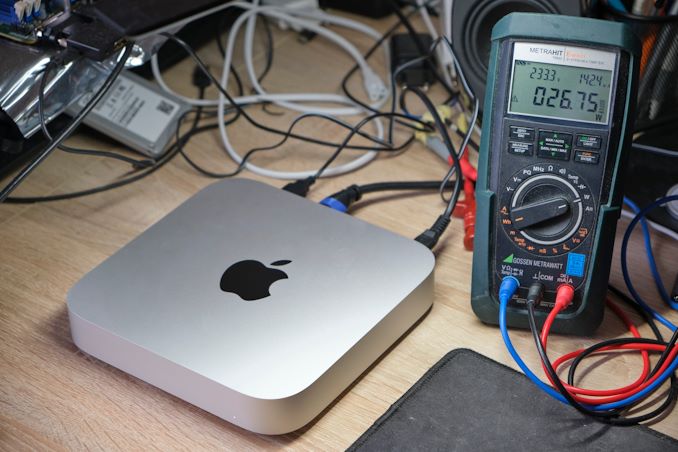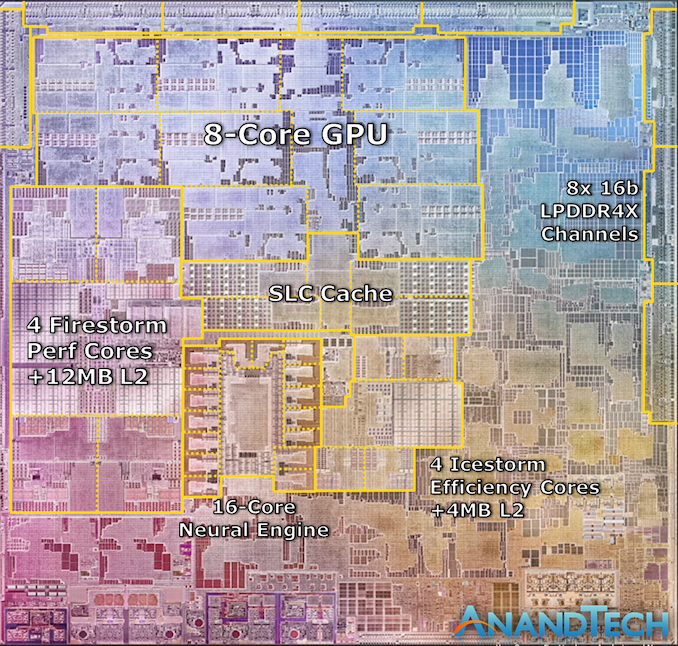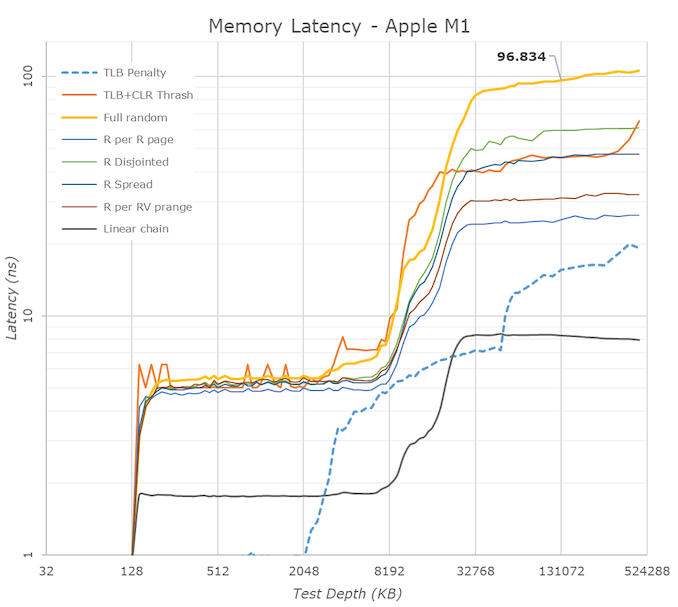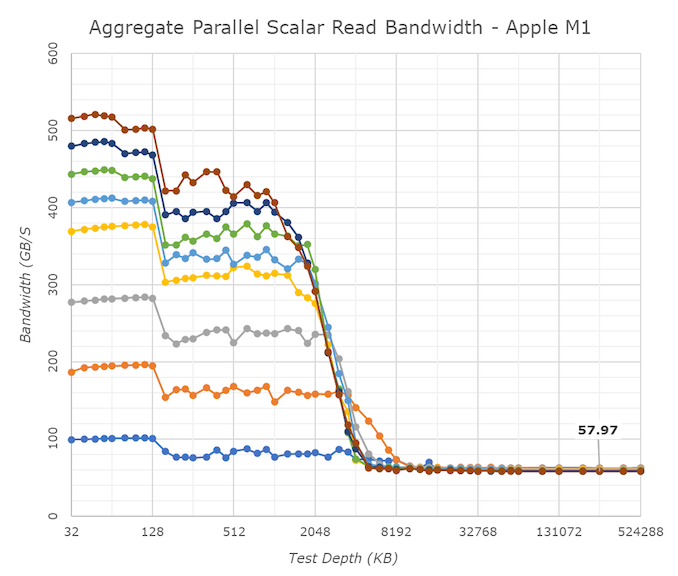The 2020 Mac Mini Unleashed: Putting Apple Silicon M1 To The Test
by Andrei Frumusanu on November 17, 2020 9:00 AM EST
Last week, Apple made industry news by announcing new Mac products based upon the company’s new Apple Silicon M1 SoC chip, marking the first move of a planned 2-year roadmap to transition over from Intel-based x86 CPUs to the company’s own in-house designed microprocessors running on the Arm instruction set.
During the launch we had prepared an extensive article based on the company’s already related Apple A14 chip, found in the new generation iPhone 12 phones. This includes a rather extensive microarchitectural deep-dive into Apple’s new Firestorm cores which power both the A14 as well as the new Apple Silicon M1, I would recommend a read if you haven’t had the opportunity yet:
Since a few days, we’ve been able to get our hands on one of the first Apple Silicon M1 devices: the new Mac mini 2020 edition. While in our analysis article last week we had based our numbers on the A14, this time around we’ve measured the real performance on the actual new higher-power design. We haven’t had much time, but we’ll be bringing you the key datapoints relevant to the new Apple Silicon M1.
Apple Silicon M1: Firestorm cores at 3.2GHz & ~20-24W TDP?
During the launch event, one thing that was in Apple fashion typically missing from the presentation were actual details on the clock frequencies of the design, as well as its TDP which it can sustain at maximum performance.
We can confirm that in single-threaded workloads, Apple’s Firestorm cores now clock in at 3.2GHz, a 6.66% increase over the 3GHz frequency of the Apple A14. As long as there's thermal headroom, this clock also applies to all-core loads, with in addition to 4x 3.2GHz performance cores also seeing 4x Thunder efficiency cores at 2064MHz, also quite a lot higher than 1823MHz on the A14.
Alongside the four performance Firestorm cores, the M1 also includes four Icestorm cores which are aimed for low idle power and increased power efficiency for battery-powered operation. Both the 4 performance cores and 4 efficiency cores can be active in tandem, meaning that this is an 8-core SoC, although performance throughput across all the cores isn’t identical.
The biggest question during the announcement event was the power consumption of these designs. Apple had presented several charts including performance and power axes, however we lacked comparison data as to come to any proper conclusion.
As we had access to the Mac mini rather than a Macbook, it meant that power measurement was rather simple on the device as we can just hook up a meter to the AC input of the device. It’s to be noted with a huge disclaimer that because we are measuring AC wall power here, the power figures aren’t directly comparable to that of battery-powered devices, as the Mac mini’s power supply will incur a efficiency loss greater than that of other mobile SoCs, as well as TDP figures contemporary vendors such as Intel or AMD publish.
It’s especially important to keep in mind that the figure of what we usually recall as TDP in processors is actually only a subset of the figures presented here, as beyond just the SoC we’re also measuring DRAM and voltage regulation overhead, something which is not included in TDP figures nor your typical package power readout on a laptop.

Starting off with an idle Mac mini in its default state while sitting idle when powered on, while connected via HDMI to a 2560p144 monitor, Wi-Fi 6 and a mouse and keyboard, we’re seeing total device power at 4.2W. Given that we’re measuring AC power into the device which can be quite inefficient at low loads, this makes quite a lot of sense and represents an excellent figure.
This idle figure also serves as a baseline for following measurements where we calculate “active power”, meaning our usual methodology of taking total power measured and subtracting the idle power.
During average single-threaded workloads on the 3.2GHz Firestorm cores, such as GCC code compilation, we’re seeing device power go up to 10.5W with active power at around 6.3W. The active power figure is very much in line with what we would expect from a higher-clocked Firestorm core, and is extremely promising for Apple and the M1.
In workloads which are more DRAM heavy and thus incur a larger power penalty on the LPDDR4X-class 128-bit 16GB of DRAM on the Mac mini, we’re seeing active power go up to 10.5W. Already with these figures the new M1 is might impressive and showcases less than a third of the power of a high-end Intel mobile CPU.
In multi-threaded scenarios, power highly depends on the workload. In memory-heavy workloads where the CPU utilisation isn’t as high, we’re seeing 18W active power, going up to around 22W in average workloads, and peaking around 27W in compute heavy workloads. These figures are generally what you’d like to compare to “TDPs” of other platforms, although again to get an apples-to-apples comparison you’d need to further subtract some of the overhead as measured on the Mac mini here – my best guess would be a 20 to 24W range.
Finally, on the part of the GPU, we’re seeing a lower power consumption figure of 17.3W in GFXBench Aztec High. This would contain a larger amount of DRAM power, so the power consumption of Apple’s GPU is definitely extremely low-power, and far less than the peak power that the CPUs can draw.
Memory Differences
Besides the additional cores on the part of the CPUs and GPU, one main performance factor of the M1 that differs from the A14 is the fact that’s it’s running on a 128-bit memory bus rather than the mobile 64-bit bus. Across 8x 16-bit memory channels and at LPDDR4X-4266-class memory, this means the M1 hits a peak of 68.25GB/s memory bandwidth.
In terms of memory latency, we’re seeing a (rather expected) reduction compared to the A14, measuring 96ns at 128MB full random test depth, compared to 102ns on the A14.
Of further note is the 12MB L2 cache of the performance cores, although here it seems that Apple continues to do some partitioning as to how much as single core can use as we’re still seeing some latency uptick after 8MB.
The M1 also contains a large SLC cache which should be accessible by all IP blocks on the chip. We’re not exactly certain, but the test results do behave a lot like on the A14 and thus we assume this is a similar 16MB chunk of cache on the SoC, as some access patterns extend beyond that of the A14, which makes sense given the larger L2.
One aspect we’ve never really had the opportunity to test is exactly how good Apple’s cores are in terms of memory bandwidth. Inside of the M1, the results are ground-breaking: A single Firestorm achieves memory reads up to around 58GB/s, with memory writes coming in at 33-36GB/s. Most importantly, memory copies land in at 60 to 62GB/s depending if you’re using scalar or vector instructions. The fact that a single Firestorm core can almost saturate the memory controllers is astounding and something we’ve never seen in a design before.
Because one core is able to make use of almost the whole memory bandwidth, having multiple cores access things at the same time don’t actually increase the system bandwidth, but actually due to congestion lower the effective achieved aggregate bandwidth. Nevertheless, this 59GB/s peak bandwidth of one core is essentially also the speed at which memory copies happen, no matter the amount of active cores in the system, again, a great feat for Apple.
Beyond the clock speed increase, L2 increase, this memory boost is also very likely to help the M1 differentiate its performance beyond that of the A14, and offer up though competition against the x86 incumbents.
- Page 1: Apple Silicon M1: Recap, Power Consumption
- Page 2: Benchmarks: Whatever Is Available
- Page 3: M1 GPU Performance: Integrated King, Discrete Rival
- Page 4: SPEC2006 & 2017: Industry Standard - ST Performance
- Page 5: SPEC2017 - Multi-Core Performance
- Page 6: Rosetta2: x86-64 Translation Performance
- Page 7: Conclusion & First Impressions













682 Comments
View All Comments
Spunjji - Thursday, November 19, 2020 - link
Their 8-core Tiger won't come in under 45W.hanskey - Wednesday, November 18, 2020 - link
Yeah.Apple is generally only relevant to users with more money than sense historically, and this is why their PC market share is a joke and their tablet and phone market share are ever shrinking - because they are not competitively priced.
Generally speaking, Apple products are for computer-device users who are not very tech savvy and who do not seek the best total-cost-of-ownership for their performance requirements, easily swayed by "the cool factor", and who also don't mind vendor lock in, the lack of reasonable pricing for minor upgrades, expensive repairs, and giving control over to Apple to decide what software you get to use. These are all problems for the vast majority of computer device users, which in addition to being very overpriced are why long term Apple just gets less relevant with each passing year.
A nice CPU for some use-cases will not solve for any of that, I'm afraid. Don't get me wrong, I'm a CPU architecture nerd and they've impressively reached close to single-threaded feature parity with some of the neatest bits I can think of, but it remains to be seen if these cores can scale as they have been, but none of that matters like it would if VIA or a Chinese x86 manufacturer did they same on an open platform, because of Apple's terrible business practices.
Upsider - Wednesday, November 18, 2020 - link
Had to log in to thank you for this. I needed the laugh today!KoolAidMan1 - Wednesday, November 18, 2020 - link
People on day one are literally running 12k raw video files with no drops, beyond Apple's example of running 8k video with no stutter in DaVinci Resolve. Their bottom end chip is performing as well as or better than Intel-based systems that cost twice as much, but yeah, its for more people with money than sense.Cope.
blackcrayon - Wednesday, November 18, 2020 - link
"Generally speaking, Apple products are for computer-device users who are not very tech savvy"Must be why Google uses them. And that UNIX shell. Another non tech savvy user feature. The vast majority of desktop users use Windows PCs. And 99% of them design their own computers from scratch, then write software to run on top of it.
You should be ashamed of yourself.
Silver5urfer - Friday, November 20, 2020 - link
Googleers are the worst fools of Software development, they are chasing the same garbage Macbook system of Locked garbage and fake privacy features, the Android OS is rotting from inside out, they are shaking up fundamentals such as filesystem support to a sandboxed garbage Scoped Storage mess with SAF framework on top, their Chromebooks are utter garbage. The OS doesn't even have Native Apps it uses Android yet they don't have SD card access properly, the machine cannot boot into other OSes properly as well. The UI is a mess and it is made for the literal non tech savvy users just need a basic computer - Like Kids, that's why in US many schools got them and they were very cheap too.Coming to MS, same the Windows 10 UX is a mess because the garbage OS looks like a mobile OS first and then they are killing the information density to accomodate the touch screen system they could simply made 2 UX options on first boot but they don't and on top they kill Control Panel and more desktop centric system with the sub par Metro UI/Fluent system which puts lot of emphasis on the ugly design on top of the least productive workflow with the OS in terms of a Desktop OS. Their Surface Books are same trash like that they use Intel but the problem is they gate every single BIOS control with zero user tweak option and they added S mode and all sorts of garbage to block exe but it failed so backtracked on top. They are going in the same walled garden utopian approach of WaaS, As a Service unstable mess of an OS with every 6 months of hell with a beta for a damn Desktop OS and using Home version userbase as guniea pigs.
Google gets the prize since their Pixel was an iPhone clone from day 1, they aped the iPhone 6 design with Pixel made by HTC, and then advertised 3.5mm jack but axed it with Pixel 2 and with Pixel 3 that Insane notch got a copy paste to the 3XL with the world's worst notch ever, and then with Pixel 4 they yanked the HW so bad that it doesn't get proper battery missing ton of features, their Software is subpar beta and their Apps like Pixel recorder where one records the Sound one cannot even see them on the storage thanks to Scoped disaster storage they have to hit share that level of copying is going on at Google fools and then the best part, their marketshare since 5 generations - less than 3%, which is less than Huawei which was blocked by CFIUS, that share of Huawei was through Honor.
Ofc you are not even capable of understanding all of this but again say something like that you said to the OP. Keep it up inb4 others come and try, google Scoped Storage Commonsware and then if you understand then we can talk.
Spunjji - Monday, November 23, 2020 - link
Would love to see Silver5urfer's posts run through analysis software and compared to Quantumz0d. Even if they're not the same person, the overlap is fascinating.Spunjji - Thursday, November 19, 2020 - link
One of my most frugal developer friends codes on an ancient MacBook Air. But sure. 😂Sandbo - Sunday, November 22, 2020 - link
And the history has been history with M1, actually. You can try to show me a laptop with the performance of MacAir base model while maintaining the same battery life.RAM is one limit but for lots of people who only use the laptop for web browsing and maybe zoom, like students, this is the no brainer laptop to me.
Xanadu1977 - Wednesday, November 18, 2020 - link
It would interesting to see (if ever) and Arm based CPU could be paired with a discrete high end GPU from AMD or Nvidia like a 6800xt, 2060 super, 3070 or better.